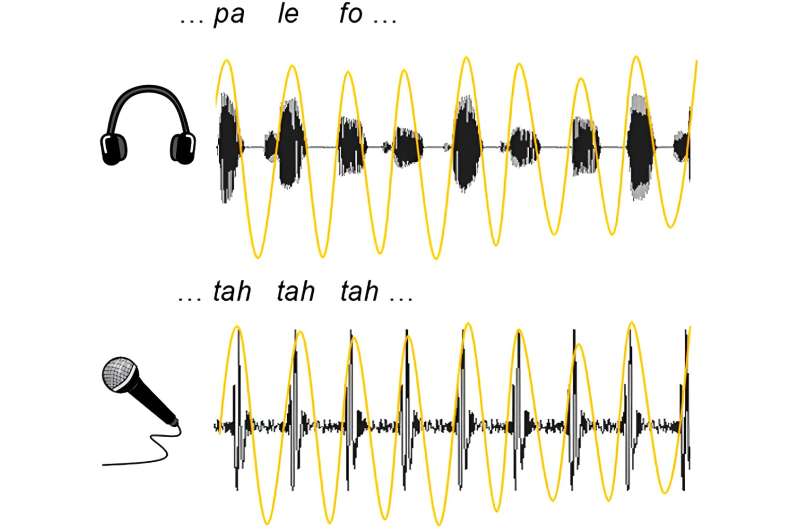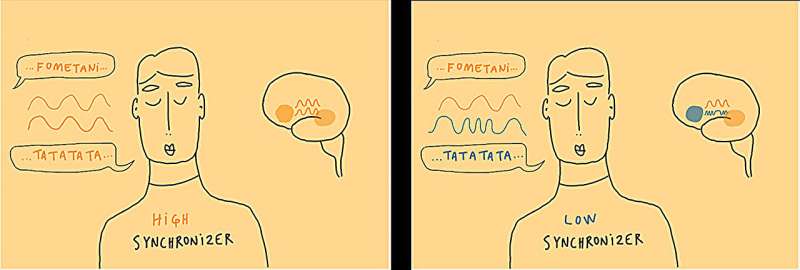This article has been reviewed according to Science X's editorial process and policies. Editors have highlighted the following attributes while ensuring the content's credibility:
fact-checked
trusted source
proofread
Do you have an ear for languages? It may be related to how you perceive the rhythms

A test that shows how good or bad we are at perceiving the rhythm of language can predict the ability to acquire language. The test results may also help us understand individual differences in brain biology.
The brain is a complex and intricate mechanism, and how our brain processes language can also tell us something about other characteristics, advantages or challenges that we have.
We begin to hear speech when we are in the womb, and the first thing a fetus perceives is the rhythm of language. An analysis of people's ability to tune into the rhythm of language and what this entails has recently been published in Communications Psychology.
Professor Mila Vulchanova has spent her whole life studying language comprehension, language development and how the brain works to handle language. She has run the language laboratory at NTNU for almost 20 years. Here, researchers have made important discoveries and have often challenged established theories.
Guro S. Sjuls, a Ph.D. candidate in Vulchanova's lab, was the first author of the new article, which is linked to synchronization to rhythm in language.
Some people find the beat straight away, others take a little longer
The essence of the research is the implementation and analysis of the Speech-to-Speech Synchronization (SSS) test. This is a seemingly simple method used to measure people's ability to synchronize their speech or language with an external speech signal.
The test involves participants hearing syllables and having to continuously reproduce the rhythm of the syllables. The syllables the participants hear are played at a frequency of 4.5 hertz, which is the average syllabic rate across languages; this basically means that there is room for 4–5 syllables per second in a single sequence.
"Some people find the beat straight away and are very good at keeping in time, while others are more hesitant. This enables us to place them into two groups," Sjuls said.
The people in the two groups are defined as high synchronizers, who are good at synchronizing to the rhythm of speech they hear, and low synchronizers, who are not as good at synchronizing to the rhythm of speech.
The SSS test involves participants synchronizing their speech in relation to pre-recorded speech.
"Interestingly, we found that this ability is not evenly distributed in the Norwegian population. Some individuals naturally synchronize their speech with the external signal, while others do not. Previous research has shown that this difference remains consistent over time, indicating that the ability to synchronize is a stable characteristic," Sjuls said.
Differences in brain structures and functions gives different abilities
The two groups have significant differences in brain structure and function.
"High synchronizers have a stronger connection between the part of the brain that perceives language and the part that produces language," Vulchanova said.
The two groups also perform differently on different tasks. High synchronizers learn the sound of new words significantly better than low synchronizers. More importantly, in high synchronizers, there are strong associations between the ability to synchronize, brain-to-language signal synchronization, and connections between linguistic networks.

A language bridge in the brain
The arcuate fasciculus is a part of the brain that is important for language. It contains both long and short fibers that connect the frontal, parietal and temporal lobes. It acts as a kind of bridge between the posterior (temporal) and frontal areas of the brain. The ability to learn new words is dependent on efficient and rapid communication between the temporal and frontal areas.
The arcuate fasciculus plays an important role in the brain's ability to process and learn language. The arcuate fasciculus has a curved shape and is usually larger in the left hemisphere than in the right.
A previous study from 2019 has shown that people belonging to the high synchronizers group generally have an arcuate fasciculus that is more strongly lateralized to the left (i.e., a larger structure in the left hemisphere of the brain).
Some theories on the origin of language (evolution) see connections between the development of stronger left lateralization of the arcuate fasciculus and the development of the ability to produce and use language in humans compared with our close relatives the primates.
May be innate
The Speech-to-Speech Synchronization (SSS) test has previously been used for English, German, Spanish and Mandarin speakers. Sjuls, Vulchanova and Assaneo have now investigated whether the test can also be used for the Scandinavian languages. Their findings show that it can. Norwegian speakers can also be divided into high and low synchronizers.
"In our study, we replicated previous results with a group of Norwegian speakers. It shows that the SSS test can be used for languages other than those already investigated. Our study supports that the test could reflect universal language user traits," Sjuls said.
The words and syllables that the test participants heard were synthesized from Swedish and English.
"We have also demonstrated that different synchronization abilities also apply to native speakers of Norwegian and that this skill is not dependent on the type of language stimuli used for testing. In other words, this ability is probably not dependent on language experience," Vulchanova said.
"The ability to synchronize may be innate, and it can also be speculated whether this ability is related to language acquisition and how well individuals are equipped to learn language," she said.
An important tool in future research
The researchers conclude that the test has the potential to be a reliable tool for future research. The findings provide opportunities for further research exploring synchronization abilities across a broader range of languages and linguistic characteristics.
The results are promising with regard to understanding individual differences in brain biology that support the links between auditory and motor functions. These connections play a crucial role in language because they form bridges between the sounds we perceive and the plans for engaging the language organs (lungs, vocal cords, mouth, tongue).
"Our next step is to find out whether or not the ability to synchronize is innate, and whether there are any factors that affect it," Sjuls said.
"We can get clearer answers about whether the ability is innate by studying newborns, for example. In an ongoing large-scale EU project, we are also looking at whether synchronization activity in the brain can be linked to and predict language skills in Norwegian preschool children," Vulchanova said.
More information: Guro S. Sjuls et al, Replication of population-level differences in auditory-motor synchronization ability in a Norwegian-speaking population, Communications Psychology (2023). DOI: 10.1038/s44271-023-00049-2

















